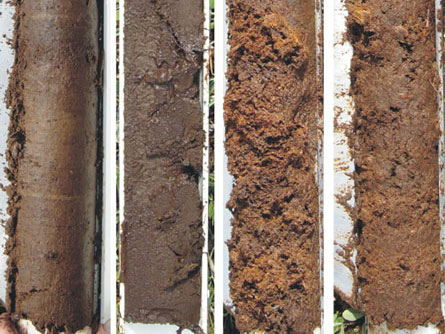A rapid expansion of Alaskan peatlands at the end of the ice age was fueled by highly seasonal climate conditions, a new analysis suggests. The finding raises the possibility that future warming could decrease or reverse carbon storage in peatlands and thereby further aggravate climate change.

The study, published online the week of April 5 in the Proceedings of the National Academy of Sciences, shows that most of Alaska’s peatlands formed at a time when the region experienced warmer summers and colder winters than today.
Paleoecologists Zicheng Yu and Miriam Jones of Lehigh University in Bethlehem, Pa., analyzed core samples from peatlands, as well as data collected by other teams, to trace the expansion of peatlands in Alaska since the peak of the most recent ice age. The oldest of these prodigious storehouses of carbon first appeared about 18,000 years ago, a couple of millennia before such boggy areas appeared in Siberia and other high-latitude areas.
And those boggy regions expanded quickly: More than 75 percent of the Alaskan peatlands that have been dated are more than 8,600 years old, Yu says. The data indicate that Alaska’s peatlands, which together cover an area 50 percent larger than California, got a substantial head start on their Siberian counterparts. “These areas formed about 2,000 years earlier than in other regions,” says Yu. Many of those peatlands formed as climate warmed near the end of the most recent ice age, when rainfall increased and runoff gathered in low spots on the formerly arid tundra.
Previous estimates of Alaska’s peatland coverage varied widely and information is still scant, says David Beilman, an environmental scientist at the University of Hawaii at Manoa. Nevertheless, he notes, “Alaska has needed a detailed inventory of its peatlands, and [Yu and Jones] did a nice job of collating existing information.”
Rates of carbon storage in Alaskan peatlands were highest when those boggy areas were young. Between 11,500 and 8,600 years ago, each square meter of peatland accumulated about 20 grams of carbon each year on average, Yu and Jones find. More recently, since 8,600 years ago, the average annual rate of carbon sequestration has been only 5 grams per square meter.
The prodigious rates of carbon storage before 8,600 years ago were triggered by huge differences in the seasons then, the researchers contend. In that era, summers were about 2 degrees Celsius warmer than they are now, so peat mosses grew more quickly. Plus, winters were substantially colder than today’s, so the peat that accumulated during the summer didn’t decompose so quickly in the off-season.
The team’s new analyses show that, surprisingly, the rate of peat accumulation depended more strongly on increased seasonality than it did on the amount of annual precipitation, Yu adds.
This newfound link between carbon accumulation and climate variability is “interesting and provocative,” says Philip Camill, a biogeochemist at Bowdoin College in Brunswick, Maine. “The warm summers and cold winters were like a one-two punch that maximized carbon accumulation.”
By the end of this century, summers in Alaska are expected to be between 3 and 5 degrees C warmer than they are today, says Camill. But that doesn’t necessarily bode well for carbon accumulation in peatlands, he notes, because winters are expected to be between 7 and 8 degrees C warmer as well. “There will be more productivity in the summer but more decomposition in the winter,” he says, so it’s tough to estimate whether peatlands will remain a repository for carbon or whether they’ll begin to release more carbon than they accumulate. “It’s not clear what the new balance will be,” he notes.
Studies suggest that between one-quarter and one-third of the carbon stored in the world’s soils since the last ice age has accumulated in high-latitude peatlands. Many scientists are concerned about changes in arctic climate that could trigger carbon emissions from peatlands, especially those that accelerate decomposition by warming the soil or drying it, which allows oxygen-rich air to infiltrate surface layers.






